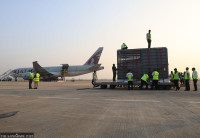Lumbini Province
Lumbini’s Buddhist meditation centre was built last year, but its roof is already leaking
Officials decry ‘gross negligence’ by the contractor assigned to build the centre.
Manoj Paudel
Friday was a rainy day in Lumbini, the birthplace of Lord Buddha. Various parts of Nepal have been witnessing light, unseasonable rainfall for the past week or two but in Lumbini on Friday, it exceeded its usual density. Still, the day would have gone unremarked if it was not for reports that the International Buddhist Hall and Meditation Centre was deluged and close to flooding. The centre’s roof had leaked in the rain.
This was unusual for a centre that was inaugurated less than a year ago, on May 16, 2022. The centre sprawls across an area of 8,300 square metres, and leaks in not one, not two but 32 spots on the ceiling.
Immediately upon getting information about the leaking roof on Friday, the Lumbini Development Trust’s board members, council members and technicians rushed to the site. The visiting team inspected the whole structure from the walls to the floor to the ceiling, according to Gopi Krishna Sharma, a member of the Trust’s council.
“We found the roof was leaking in 32 places,” Sharma said, adding that they collected evidence of the contractor’s poor work and showed it to the Minister for Culture, Tourism, and Civil Aviation, Sudan Kirati. “Action will be taken against both contractors and consultants who have done such a shoddy job at such an important structure,” Sharma said. But this was hardly surprising for Sharma, who had received reports of the roof leaking just three months after the inauguration last year.
The International Buddhist Hall and Meditation Centre is said to be a state-of-the-art facility, one that can host spiritual conferences, meetings, and meditation programmes, among others. It can host as many as 5,000 people. It has heating and cooling technology, sensor doors, a mosaic floor and speech translation facilities in 16 different languages. The umbrella-style roof was supposed to be made with soundproof and waterproof materials, according to Sharma.
The construction was divided into two phases—the physical structure construction and its beautification. On March 20, 2018, an agreement was signed with Lumbini, Arghakhanchi Babul JV at Rs280.1 million for the first phase and Rs340.9 million for the second phase, according to Netra Shahi, a board member of the Lumbini Development Trust.
But given what appears to be shoddy construction work, the Trust has withheld payment to the contractor, Shahi said.
“We will withhold pay until they submit a report for this unacceptable construction work and fix the problem,” he said.
Shahi says the shoddy construction work of the centre reflects poorly on the Trust and the overall master plan. “It is shameful,” he said. “This episode will send a negative message to the international community as well.”
The centre was long in the making. Its construction falls under the Lumbini Development Master Plan. The Lumbini Development Trust, which is overseeing the implementation of the master plan, was established in 1985 to accelerate the work. The master plan, which the International Buddhist Hall and Meditation Centre is a part of, was designed by Kenzō Tange, an eminent Japanese architect, and was approved by the Nepal Government and the United Nations in 1978. The plan was supposed to be completed by 1995.
On Buddha Jayanti in 2017, the then Prime Minister KP Sharma Oli, who was attending an event, announced the construction of the centre and a year later, the then President Bidya Devi Bhandari laid the foundation stone of the centre.
Meanwhile, the contractor company has deployed a team to identify structural issues with the centre. “The leakage might have occurred because the structure has not set in properly,” Santosh Adhikari, director of Lumbini, Arghakhanchi Babul JV, told the Post. “Technicians are working towards fixing the problem at the earliest.”
The construction of the hall was completed in four years, a year more than the deadline. The main infrastructure work was completed in the first phase while the finishing and beautification works were completed in the second phase.
The meditation centre stands on 140 piles of foundations constructed at a depth of 10 metres. The roof is supported by 40 pillars built on the foundation. A Chinese brick wall facade has been installed to keep the meeting hall closed from all sides. There are three main sensor doors—eight metres wide and two metres high—to enter the hall. There are also 52 manual doors—four metres high and two and a half metres wide. The hall has been constructed inside the land which is surrounded by a 38,000 square metres boundary wall.
The second phase included finishing, colouring, and garden and canteen constructions. Three toilet blocks housing 28 toilets, including urinals and commodes, that can provide services to 25 people have also been constructed.
Likewise, the installation work of the sound system has also been completed.
As it is a place for meditation, the interior has completely been painted white with a yellow lotus painted on the ceiling of the hall.
Similarly, 476 lights have been installed and a WiFi zone has also been created.
Prahalad Yadav, a local man, says the shoddy construction work in the centre has dampened the spirit of the locals since they take this project as a pride project for the birthplace of Buddha. “The carelessness and negligence of the concerned authorities, stakeholders and contractors have led us all to this moment of embarrassment,” Yadav said. “It is the first hall in the country with state-of-the-art facilities. However, the leakage before the handing over of the hall shows carelessness and irresponsibility on the Trust’s part.”




 15.12°C Kathmandu
15.12°C Kathmandu














